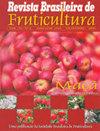Host status of stinking passion flower and yellow passion fruit to Rotylenchulus reniformis, Meloidogyne javanica and Pratylenchus brachyurus
IF 0.9
4区 农林科学
Q4 HORTICULTURE
引用次数: 1
Abstract
Abstract Stinking passion flower (Passiflora foetida L.) is an herbaceous vine used due its medicinal properties. It could be an option to be used as a rootstock for sour passion fruit (P. edulis). This interest was especially motivated by its resistance to Fusarium oxysporum f. sp. passifloraeand F. solani, two soilborne pathogens that severely limit the sour passion fruit cultivation in Brazil. Phytonematodes are other important soil pathogens to most crops, including Passiflora species, and they often interact synergistically with pathogenic Fusarium spp. strains. However, the host status of stinking passion flower to phytonematodes was not assessed yet. Therefore, three pot experiments were carried out in order to assess the reproduction of Rotylenchulus reniformis, Meloidogyne javanica and on Pratylenchus brachyurusstinking passion flower and sour passion fruit. Both P. foetida and P. edulis were susceptible to R. reniformis, but immune (or highly resistant) to both M. javanica and P. brachyurus. Based on previous and the present work, R. reniformis stands out and could be pointed as the most important species to species of Passiflora.臭西番莲花和黄西番莲果对臭西番莲花、黄西番莲花和臭西番莲花的寄主地位
摘要西番莲(Passiflora foetida L.)是一种草本藤本植物,因其药用特性而被广泛使用。它可以作为酸百香果(P. edulis)的砧木。这种兴趣尤其被其对两种严重限制巴西酸百香果种植的土传病原体——passifloria oxysporum f. spe .和f. solani的抗性所激发。植物线虫是大多数作物的其他重要土壤病原体,包括西番莲物种,它们经常与致病性镰刀菌菌株协同作用。然而,对西番莲对植物线虫的寄主地位尚未进行评价。为此,进行了3个盆栽试验,研究了Rotylenchulus reniformis、Meloidogyne javanica和Pratylenchus brachyurus臭西番莲花和酸西番莲果的繁殖情况。foetida和edulis对reniformis均敏感,但对javanica和brachyurus均免疫(或高度抗性)。综合以往和目前的研究成果,西番莲属植物中最重要的一种是reniformis。
本文章由计算机程序翻译,如有差异,请以英文原文为准。
求助全文
约1分钟内获得全文
求助全文
来源期刊
CiteScore
1.50
自引率
20.00%
发文量
34
审稿时长
4-8 weeks
期刊介绍:
The Revista Brasileira de Fruticultura (RBF) publishes technical articles and scientific communications in the area of fruit crops, referring to results of original searches and unpublished papers in Portuguese, Spanish or English, and 1 or 2 reviews per edition, of invited authors.

 求助内容:
求助内容: 应助结果提醒方式:
应助结果提醒方式:


